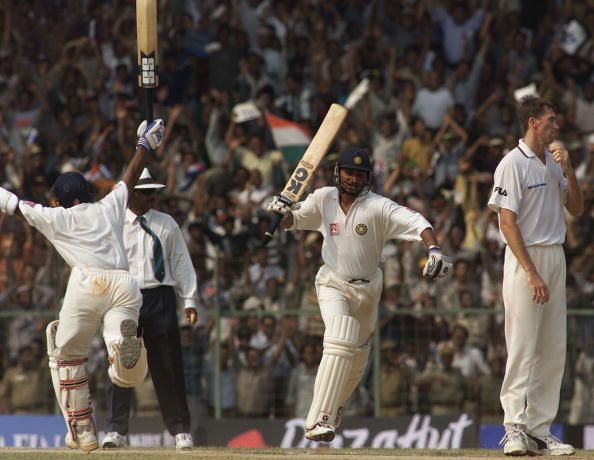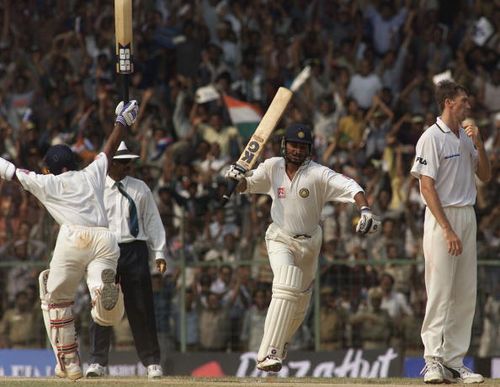
The series that set the ball rolling for Indian Cricket

Cricket played by men clad in white clothes has always enticed me more than the action that unfolds when men in color clothes play the game. With the exception of Tendulkar, ODI cricket wasn’t as austere as test cricket was. Hailing from Madras, a city with a rich test cricket heritage, a brahmin family which vouched for the purity of the game, there was an innate liking towards Test cricket.
Some of the most riveting contests in Test cricket of my generation were between the heavyweights, the Kangaroos and the Tigers. It was a blood gushing affair, as the trash talk off field and on field were high, and the cricket of course was top class. The contest on field too was high voltage. Usurping a team right at the top gives you an inexplicable sense of joy and that was what made the contest as captivating as it was.
The aftermath of 2000, the darkest period of Indian cricket saw one of the most awe inspiring resurgence of Indian cricket. Labeled sitting ducks abroad, Indians rewrote history and conquered the crest in one decade, winning in every nook and corner of the cricketing globe. The series that set the ball rolling for India was Australia in India 2001. Australia were in terrific form and oozing with confidence enjoying a 15-match winning streak. India on the other hand were just recuperating from the match fixing scandal and most players in the team were in the primitive stages of their careers.
Pummeling things further for India was the absence of Anil Kumble. In the spinning conditions in India, the captain would be more than disheartened to miss Kumble, India’s lead spinner. The other spinners in the country who could substitute Kumble had less than test tests in their kitty. At this juncture, the legendary captain Ganguly was, handpicked Harbhajan Singh and entrusted him with the huge responsibility of spearheading the Indian spin attack. This raised quite a few eyebrows as Harbhajan’s previous best was 3/30 and he was ousted from the national side due to disciplinary issues. However, given the ruthless instincts of Ganguly, Harbhajan was India’s lead spinner.
The first Test at Mumbai saw the entire nation holding its breath in front of the television, and the TRP ratings soared. The first Test was a forgettable affair for the Indians with the Australian pacers running through the Indian top order in the first Innings and putting India in a spot, 4/62 at lunch. After lunch, Sachin spearheaded a classic counter attack scoring all over the park and notching up a 53 off 53 balls. Just when the semblance of a resurrection emerged, Laxman and Tendulkar were dismissed and the Indians folded to 176.
The Australian innings started off on a dull note as well with Harbhajan and Singhvi hunted in tandem and the Australians were reduced to 5/99. Mark Waugh was dismissed for a golden duck with Ganguly taking a catch of his lifetime, a one handed diving catch at close range. Gilchrist hijacked the innings and his onslaught proved to be too costly for the Indians and he bailed out Australia to a decent 349. The second innings was no different for India, as India were bowled out for 219 with Tendulkar scoring a 65 and Rahul grilling the Australian attack. Tendulkar’s dismissal here was very unfortunate as a pull shot from him hit Langer and forward short leg and rebounded in the air to be caught by Ricky Ponting. With 47 to win for the Aussies in the fourth innings, India had lost the Test. Australia had extended its winning streak to a whopping 16 matches and Indians were hit hard with the media and former players plotting a whitewash.
The second Test at Kolkata was a do or a die game for the Indians and as the pressure mounted Indians succumbed to it and were bowled out for a paltry 171 in reply to Australia’s mammoth 445 led by a century from captain Steve Waugh. Having forced to follow on, Indians were virtually out of the game and out of the series. The public mood was lull and a billion hopes had fallen. In the history of Test cricket, no team has struck back having put to follow on. History doesn’t announce itself, it just happens on the go and so did the monumental partnership between Rahul Dravid and Laxman. 376 runs spanning an entire day, with VVS Laxman playing one of the best test knocks ever. 281 not out, the most classy knock, studded with wristy on drives and stylish cover drives, in supreme authority over the bowling, a knock of a life time, the knock of the decade and arguably the knock of test cricket. Well complemented by Rahul Dravid, playing one of the best second fiddles ever, setting Australia a 384 to win. Australia started off safely to play out the game for a draw.